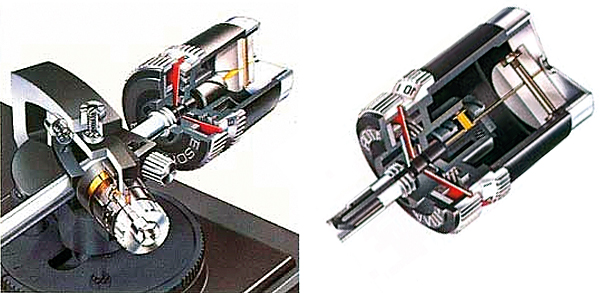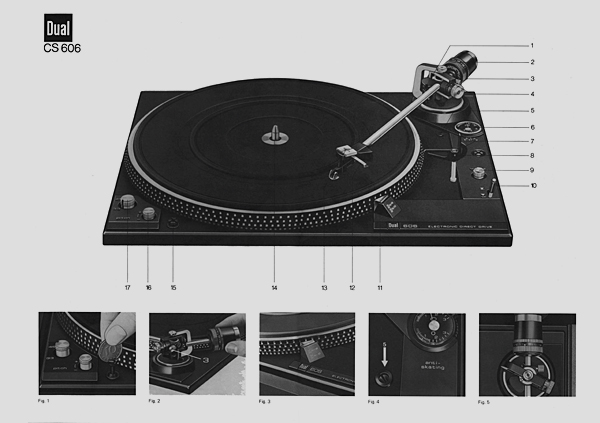Dual CS 606 turntable

 With its ultra low mass arm and cartridge system, the CS 606 was one of a trio of decks that was finally able to claw back sales from the Japanese. How does it perform today?
With its ultra low mass arm and cartridge system, the CS 606 was one of a trio of decks that was finally able to claw back sales from the Japanese. How does it perform today?
The fact that Dual couldn't achieve serious success in the middle sector of the British turntable market back in the late '70s was testament to how fast the hi-fi world had changed. That part of the market was becoming the province of Japanese companies such as Pioneer, Sony and Technics, which were making complex, technologically advanced turntables packed with modern, user-friendly features that people wanted to buy.
By contrast, Dual seemed to be building oddly styled, quirky decks that lacked the mechanical sophistication of those offered by its Nipponese competitors. To make things worse, the Japanese brands were benefiting from a cheap currency – worth roughly four times less than it is today – which meant that their turntables were very competitively priced. In other words, one of Europe's longest established and most illustrious brands found itself struggling on its own doorstep.

Black Arts
Things weren't always this way, of course. Dual had once been one of the largest turntable manufacturers in Europe. At the peak of West Germany's post-war Wirtschaftswunder, or economic miracle, it could boast over 3000 employees working in several factories across the country.
The company could trace its roots back to 1907, when brothers Christian and Joseph Steidinger began making clockwork and gramophone parts in the Black Forest town of St Georgen. In 1927, Gebrüder Steidinger made Dual the firm's brand name – a reference to the dual-mode power supplies it was making that allowed other companies' turntables to be powered either from a wind-up mechanism or AC mains. Soon after this, Dual began making record players of its own.

During the '70s it produced a series of rather ungainly looking turntables, all lacking the visual sophistication and operational slickness of similarly-priced rivals. True, the 504, which it launched in 1977, had been reasonably successful, being a decent lower-mid price belt-driven deck with a pleasant sound. Yet while this was much better looking than the 503 it replaced, it was still a little off the mark compared to the increasingly sleek and modern Japanese competition.
However, in 1979 Dual finally got its act together. The decks in the company's new '06 range, launched in Japan that year, were slimmer, less chunky and had a gentler and more delicate action. At the same time, they featured a concept that Dual called 'Ultra Low Mass'. This, the company thought, would finally clinch it and give the new range a unique selling point that would put it ahead of its rivals.
Warp Factor
Ultra Low Mass, or 'ULM', was the marketing buzzword Dual employed when the CS 506, CS 606 and CS 706 turntables were unveiled in the UK at the 1980 Harrogate show. And many were impressed. Where the previous generation of decks were equipped with medium-mass tonearms, the 'ultra low mass' of both the new arm and new generation of Ortofon-made MM cartridges appeared to be an impressive combination.

Dual explained that its new arm and cartridge combinations now enabled its turntables to ride records with warps more effectively, which was an issue increasingly preoccupying vinyl users at the time. The main reason for this was that the quality of pressings had deteriorated over recent years, LPs becoming thinner and lighter due to the mid '70s oil crisis which had seen the price of raw vinyl escalate dramatically.
Low mass was nothing new, of course. The '70s had been characterised by a move away from low-compliance cartridges and tonearms having a high effective mass to the exact opposite. By the latter half of the decade, lowish mass, high-compliance moving-magnet cartridges from brands such as Shure and Grado were hugely popular. Indeed, the SME Series III tonearm epitomised this state of affairs, being a low effective mass high-end tonearm that was built to capitalise on this trend. In truth, though, Dual was late to the party, because the market was actually beginning to move back once again towards high-mass arms and low-compliance moving-coils.

Winning Range
All the same, ULM was a concept that the more serious audio consumer understood easily and was also not difficult to sell to more mainstream buyers to whom lighter was obviously better when you were talking about playing records. At last it seemed that Dual had a winning range of upper-budget and mid-priced record decks.
The new decks came in three variants: the CS 506 was the entry-level model at £115 and was belt drive, the £150 CS 606 was the mid-priced design and was direct-drive while the £200 CS 706 was the full, all-singing-and-dancing quartz-locked variant. All featured Dual's simple end-of-side auto-stop, activated by a microswitch so as not to interfere with the working of the tonearm. This was a good middle way between fully manual decks like the Rega Planar 3, and fully automatic designs from Japan such as Pioneer's PL-600 which were more mechanically complex and, many would say, slightly compromised as a result. History records that it was the CS 506 that went on to become the real sales success of the series. It was affordable and seemed very well made for the price.
Real Filip
The CS 606 that you see here boasted electronically-governed direct drive – something that was hugely fashionable in the lower to mid sectors of the market at the time – with Dual's EDS 500 direct-drive motor system giving the fine basic mechanicals a real filip. Wow and flutter was said to be down to '0.03% WRMS', an admirably low figure that was close, on paper at least, to the best Japanese direct-drives of the day. Speeds were the usual 33.33 and 45rpm, with a pitch control of 10% to set them precisely via the illuminated strobe bars on the rim of the non-magnetic aluminium platter. The platter itself weighed 1.4kg and came topped with a rubber mat.


















































